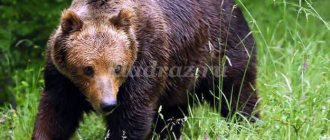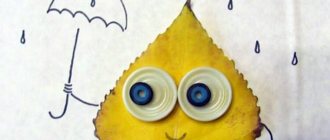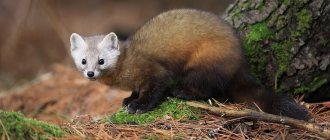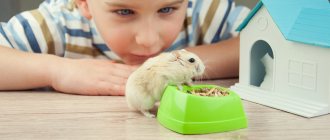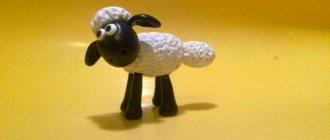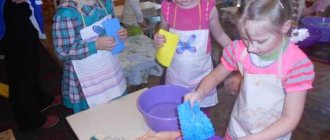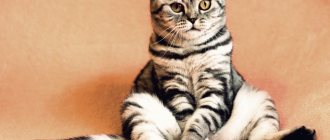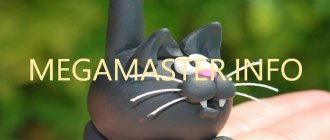Lesson summary for the senior preparatory group “Telling from personal experience “My favorite”
Natalya Pecherina
Lesson summary for the senior preparatory group “Telling from personal experience “My favorite”
Goal: to teach children to write short stories “from personal experience ”
, using both simple and complex, complex, complex sentences.
- consolidate children's knowledge about pets.
-expand children's vocabulary;
- learn to listen carefully and answer questions.
-develop children's speech, thinking, memory
-develop cognitive activity;
- to foster a humane attitude towards animals, a sense of responsibility for those who have been tamed.
Puzzles, mnemonic table, photographs, cards with images of animals;
Conversation about pets
November 30 is an international holiday dedicated to all pets. Since time immemorial, animals have lived next to humans in a large, beautiful house whose name is Earth. International Pet Day is celebrated in different countries around the world in their own way. Some people on this day allow their pets to do all the previously prohibited things: tear wallpaper, chew furniture, ride on curtains, and even eat from the table. Some go to a beauty salon with their pet, some buy their pet a huge amount of goodies, and some simply pay maximum attention to their feathered, waterfowl or four-legged friend. In many zoos around the world, on this day, children ring bells for a minute, thereby attracting attention to the problems of animals. The “Bell” campaign is gradually becoming traditional in Russian cities. International Pet Day once again reminds humanity that it is responsible for those it has tamed. Presenter 1: Hello guys! We are pleased to welcome you to a cool hour of love and kindness - “Our Pets”! Pick up photos and portraits of your little brothers. That's how many friends the kids in the class have. Presenter 2: Everyone knows that life without animals is boring and joyless. Animals make our lives more joyful, and how much kindness and affection animals bring us! Riddles about pets. Presenter 1: Let's guess the riddles that are hidden under the toys. What animals are they dedicated to? (to the family) (There are animal toys on the table, children choose an animal and guess the riddle) Savka has a piglet, two pancakes and a pretzel. He wears shoes without laces, and a suit made of bristles. (pig)
The thick grasses are braided, the meadows are curled, and I myself am all curly, even with a curl of an horn. (ram) With a beard, not an old man, With horns, not a bull, They milk, not a cow, It pulls its bast, But it doesn’t weave bast shoes. (goat) A champion in fast running, I sometimes drive carts. Uncle groom brought me water, hay and oats. (Horse)
Look, guys, this is a relative of the horse! He, sister, brother, mother, grandfather and father are all stubborn! (Donkey) She is motley, Eats green, Gives white. (Cow) I am an ordinary hen, Duck is my neighbor. It’s a pity, it’s not easy for me to take off, Whoosh, whoosh, whoosh, whoosh! (Chicken) He is proud of his position And the bird alarm clock screams Early, at six in the morning: “Hey, shepherd, it’s time to get up! Bring the herd out, ka-ka-re-ku, to the lush meadow!” (Rooster) A faithful friend to man, I sensitively hear every sound. I have an excellent sense of smell, a keen eye and keen hearing. (Dog) I arrange myself cleverly: I have a pantry with me. Where's the storage room? Behind the cheek! I'm so cunning! (x And they don’t swim in the sea, And they don’t have bristles, But they are still called sea... (guinea pigs) Who sings with his mouth closed? If he opens his mouth, he doesn’t sing. He walks with an inaudible step, He’s not afraid of the dark. And although he’s wearing a fur coat lush, Likes to bask at the stove. (Cat) “Night predators" in our house. Presenter 2: Meet those guests who will tell you “Why they called the cat a cat.” (The poem “Why they called the cat a cat” is acted out by disguised sixth-graders) At the old man’s and old women There was a black-eared kitten, Black-eared and white-cheeked, White-bellied and black-sided. The old man and the old woman began to think: “Our black-eared one is growing up. We fed him and gave him water. We just forgot to give him a name. Let’s call the black-eared one “Cloud” - Let him be big and powerful. Taller than a tree , More home. Let it purr louder than thunder! - No, said the old woman, after thinking, - A cloud is lighter than goose down. The wind drives huge clouds, gathers them into gray heaps. The wind whistles long and loudly. Should we call the Kitten “Wind”? “No, old woman,” the old man replies, “The wind only shakes the trees, but the wall remains alone.” Should we name the kitten “The Wall”? The old woman answers the old man: “You lost your hearing in old age!” Listen with me: Do you hear the mouse rustling behind the wall? A thief mouse is sharpening a tree... Should we call the cat “Mouse”? “No, old woman,” the old man answers, “the cat eats the mouse with its skin.” So the cat is a little stronger! Shouldn't we call the cat a cat? Presenter 1: Who has a cat? Tell us about your favorite. (stories from second graders)
A cat is a wayward animal, full of secrets that have not yet been solved. People have never been indifferent to cats: they painted them, sculpted them, embroidered them, photographed them, erected monuments, wrote poems and stories. Cats settled with humans 4 thousand years ago. The ancestor of the modern cat is considered to be the Libyan or Nubian cat. There are now more than a hundred cat breeds in the world. In ancient Egypt, cats were deified, temples were built for cats, festivals were held in their honor, and they were buried in special cemeteries in bronze, silver or gold coffins. In the Middle Ages, attitudes towards cats changed dramatically. Cats were seen as the embodiment of evil spirits and were considered assistants to witches. Cats were burned and their paws were cut off. In Rus', the cat was not an object of worship, but it was not subject to persecution. In Russian folk tales, the cat is almost the smartest animal. The cat himself tells fairy tales and sings songs. The Bayun cat was endowed with a voice that could be heard 7 miles away. With his purring he could induce sleep, which could not be distinguished from death. Presenter 1: Can you call yourself attentive and observant?! What does cat behavior mean? Rubbing the head against a person (Love, devotion, thirst for affection) Ears pressed to the head (Preparation for an attack) Rumbling (Discontent) Twitching the tail (Displeasure) Purring (Pleasure, calmness) Hissing (Readiness for defense) Cats are excellent at predicting weather changes. The cat covers its nose with its paws - To be frosty The cat lies with its belly up - Towards warmth The cat tears at the wall with its claws - Towards bad weather The cat to the stove - To be frosty Presenter 2: There are many superstitions associated with cats. For centuries in Europe, cats were immured in the walls of houses with a rat in their mouth. For what? (To scare away rats and other evil spirits) During a thunderstorm, a black cat was thrown out the door. For what? (They believed that they attracted lightning) It was believed that if you throw a cat overboard, a storm will arise. Why? (The cat protects the ship from the storm) The cat is the first to be allowed into the new house. For what? (To exorcise evil spirits) We still have the belief that whoever kills a cat will not see good luck for 7 years. Whoever loves and protects cats is protected by a cunning beast from all harm. Presenter 1: Cats saved people's lives. During fires, if it happened at night, cats woke up their owners with screams and restless behavior, which saved people’s lives. Cats protect human homes from rats and mice. Do you guys know that if something hurts you and the cat lies down on the sore spot, purrs and gently massages it with its paws, the disease will go away, although it’s not easy for us after such procedures, because cats absorb bad energy. Maybe that’s why they have 9 lives - because their task is to be home healers, and this is difficult and requires a lot of strength and health. Man's true friend
Presenter 2: If you stroke it, it caresses you, if you tease it, it bites you. He sits on a chain and guards the house. I won’t let a stranger into a stranger’s house. Without an owner, I’m sad. Who is this? Which one of you is the dog owner? We will be glad to hear your stories about your charges. (stories from second-graders) The dog is the first animal domesticated by man. Its ancestors are various species of wolves. Man domesticated the dog about 12 thousand years ago. This happened in many places around the world. There are various hypotheses for the domestication of dogs by humans. One of them is shared housing and shared hunting. The dog did not come to the man as a prisoner or a beggar. An equal partner in hunting and protecting common housing came to the man. Nowadays, there are over three hundred dog breeds. Presenter 1: During the Great Patriotic War, dogs helped the wounded on the battlefield, found mines and helped soldiers in reconnaissance. Both people and dogs suffered a difficult fate in those years. But dogs are no less useful in peacetime. They help visually impaired people move on the streets; dogs even have a special profession called guide dogs. They guard houses and protect from hooligans. Everyone knows that there is nothing stronger than a dog's loyalty. Proof of this is Hachiko, who waited for his owner at the station for 7 years and never left. Balto-Siberian huskies, who delivered vital medicines to people in the bitter cold of Alaska. And in the end, they are so happy to just greet you, our dear friends, when you come home. They love playing with you so much! And we really want you not to offend them, because they love you so much that they are ready to give their lives. (Song “There is no creature more devoted to a dog”) Home zoo. Presenter 2: What other animals live near you? Introduce us to them. (stories from second-graders) Presenter 1: Look at the picture and guess what kind of pets I have on the farm. Who's the odd one out here? Why? (a squirrel is a wild animal) Presenter 2: I was taking a general photograph of domestic animals, and my camera broke. Look what happened. (Picture of a miracle animal). Help me figure out which animal body parts are in the photograph. Whose tail is this? (Feline). Whose head is this? (Horse). Whose body is this? (Cow). Whose horns are these? (Lamb). Whose paws are these? (Canine). Well, now it’s clear who I photographed. Let's list the poultry Presenter 1: Do you know the story of how geese saved the city? It was a long time ago. Neither more nor less in Ancient Rome. Rome lived on and did not grieve, when suddenly the wild peoples of the Gauls attacked the Romans. There were so many of them that half of the Romans fled from the city, and the other half locked themselves in the Kremlin-Capitol. The Gauls really wanted to capture this Kremlin, to get its wealth, but they could not take it no matter how hard they tried. After all, on one side of the Kremlin there were walls and gates, and on the other side there was a steep cliff, because... the Kremlin stood on a mountain. Then the Gauls decided to climb the cliff and take the Kremlin by cunning. They climbed the cliff so quietly and quickly that not a single dog in the city heard them. But that’s not the problem - the geese sensed the rustling and began to guffaw and flap their wings. People woke up and managed to fight off the invaders. Since then, the Roman people have been honoring geese and bringing them gifts as a sign of deep gratitude! Presenter 2: It’s time to sum up the results of the class survey. Watching the cartoon “The Cat Who Walked By Itself.”
